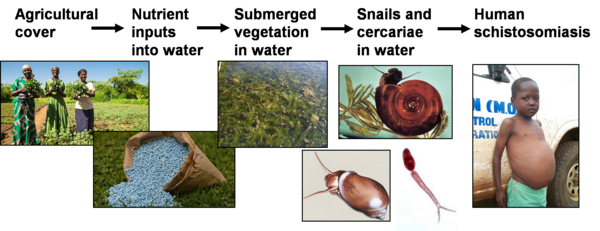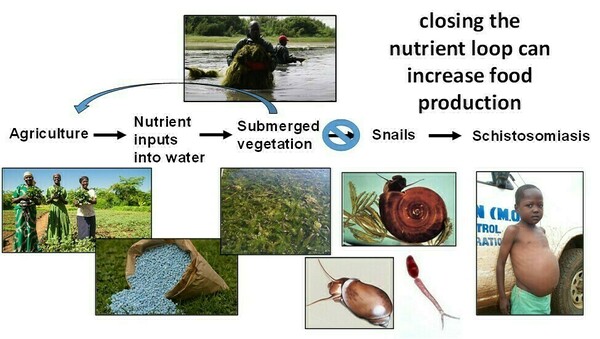Research Highlights
Introduction and Hypotheses
Schistosomiasis is caused by snail-transmitted flatworms that penetrate human skin; it reinforces poverty, adversely affects the health of children and adults, and defies control efforts, because even when infections are treated with drugs, people can quickly get re-infected when they return to snail-infested waterbodies. In Senegal, the site of our experiment, Schistosoma prevalence in children often rebounds to 70–90% within a year after drug treatment, and more than 99% of host snails are captured in the freshwater plant Ceratophyllum demersum. This plant has a mutualistic relationship with snails, is found throughout Africa, Southeast Asia and Latin America, where schistosomiasis is endemic, and along with other invasive aquatic plants, chokes out waterways impeding access to open water needed for washing clothes, irrigation and cooking. We hypothesized that agricultural development in West Africa and the associated fertilizer use has led to increases in Schistosoma infections by increasing submerged aquatic vegetation and attached algae that are the habitat and food for snails, respectively (Fig. 1).
 Fig. 1. Hypothesis for how agriculture and associated fertilizer affect human schistosomiasis.
Fig. 1. Hypothesis for how agriculture and associated fertilizer affect human schistosomiasis.
If the hypothesized pathway between agriculture and schistosomiasis is supported (Fig. 1), we hypothesized that removing aquatic vegetation should reduce human schistosomiasis by reducing habitat for intermediate hosts of the pathogen (i.e., snails) and that we could profitably improve food production and sustainability by returning the nutrients captured in the removed plants back to agriculture, thus reducing nitrogen and phosphorus pollution by partly closing the nutrient loop (Fig. 2). Additionally, privatizing the public nuisance (i.e., invasive aquatic vegetation) could provide an incentive to maintain cleared waterways and the public benefit of reduced schistosomiasis.
 Fig. 2. Hypothesis that removing aquatic vegetation should reduce human schistosomiasis by reducing habitat for snails, the intermediate host for the pathogen, and that returning the nutrients captured in the removed plants back to agriculture, thus reducing nitrogen and phosphorus pollution by partly closing the nutrient loop, should sustainability and profitably improve food production and wealth.
Fig. 2. Hypothesis that removing aquatic vegetation should reduce human schistosomiasis by reducing habitat for snails, the intermediate host for the pathogen, and that returning the nutrients captured in the removed plants back to agriculture, thus reducing nitrogen and phosphorus pollution by partly closing the nutrient loop, should sustainability and profitably improve food production and wealth.
For more information, see Rohr et al. 2023.